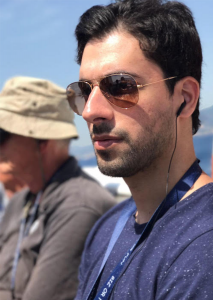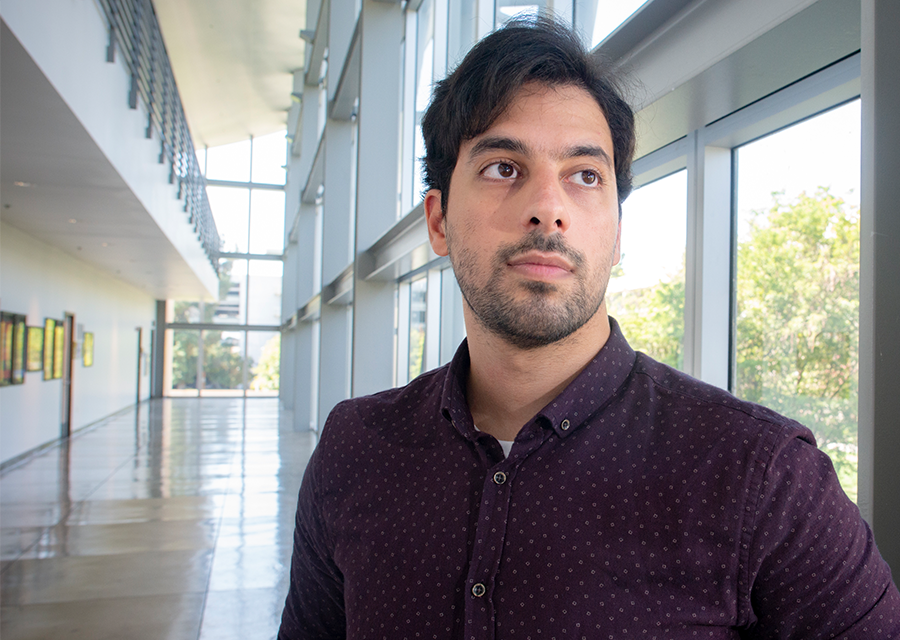Grad Student Wins $1 Million to Bring His Screenplay to Life
In the middle of a bustling Brooklyn street, a woman veiled from head to toe in a traditional Middle Eastern dress stands in the center of the chaos. Suddenly, the world slows as she lifts both hands, fingers curling around the hem of her veil. Then, she pulls off her hijab, allowing a gentle breeze to ruffle her hair and brush the soft skin of her face. She breathes, liberated.
This was only an abstract thought until CSUN Mass Communication and Journalism graduate student Abdullah Alhendyani put it down on paper. For several weeks, he worked to craft a narrative around his initial vision — who this woman is, how she got there, what happens to her after — until it formed a feature-length screenplay.

Abdullah Alhendyani. Photo courtesy of Abdullah Alhendyani.
The LAUNCH Million Dollar Screenplay Competition recently announced Alhendyani’s script, “Haram,” as its first-place winner for 2019. His winnings include a $50,000 grant, representation from a talent agency and literary management, professional screenwriting software and the coveted $1 million production budget to develop the screenplay into a feature-length film.
In its second year, The LAUNCH was founded by producers Zachary Green and Jason Shuman to help aspiring screenwriters reach their goal of seeing their ideas realized on the big screen. This year’s panel of judges included film directors, producers and casting directors, all searching for an unforgettable story that’s both original and evocative.
In the competition, Alhendyani beat out students from other major film schools including American Film Institute, USC and UCLA.
“Haram” follows the story of a young woman from a Muslim immigrant family as she falls in love with a local female tattoo artist, challenging the conservative norms of her family. Aptly named for the Arabic word for “forbidden,” the story explores culture clashes between Western and Middle Eastern ideologies and views.
Alhendyani looked to his Middle Eastern background for a unique perspective in writing his script. It has only been two years since the graduate student, half-Arab and half-Persian, first set foot in the United States from his homeland of Kuwait. The experience, he said, “hasn’t been the easiest road, especially after living in those territories.”
As a screenwriter, “the angle that I’ve come from — it’s really different from the ones of Western audiences,” Alhendyani said.
In addition to examining the arduous immigrant experience, “Haram” centers on the struggles of the LGBTQ community in the Middle East. In the region, homosexuality is still punishable by imprisonment, or sometimes death, in some countries.
Alhendyani, 27, has been writing short stories since he was in high school and has published two Arabic-language novels in the Middle East. However, he started trying his hand at screenwriting just two years ago. In 2018, a CSUN classmate read one of Alhendyani’s fledgling scripts and, impressed, encouraged him to submit his work to film festivals. In 2018, Alhendyani took the leap and entered the Austin Film Festival.
He realized that he could take screenwriting from hobby to career path when his feature script, “The Huntress,” which follows the story of a deer hunter, was selected as a finalist in the renowned film festival. It felt like a foot in the door, Alhendyani said.
“Even though it’s just one foot,” he said, “having just one foot in the door is better than having two hands on the glass, looking [through] the windows, hoping to be on the other side.”
Alhendyani followed a key piece of advice from his fellow writers: He read one screenplay after another, learning the form, the details and the imagery that meld to tell the stories in his favorite films.
With his recent win at The LAUNCH competition and his first chance to watch his written work come to life on the big screen, Alhendyani said he is beyond thrilled. The project is already moving forward, with meetings with investors and executives beginning this month.
“I’m going through this like a little child,” Alhendyani said. “Hopefully, I could be a grown-up after this stage.”


 experience
experience